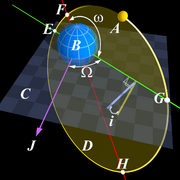دور مداري
| جزء من سلسلة عن |
| الديناميكا الفلكية |
|---|
 |
الدور المداري Orbital period هو الزمن المستغرق لدوران جرم سماوي في مداره حول جرم آخر لدورة كاملة.
العلاقة بين الأدوار السماوية و synodic
Table of synodic periods in the Solar System, relative to Earth:[بحاجة لمصدر]
| Sidereal period (yr) | Synodic period (yr) | Synodic period (d) | |
| Solar surface | 0.069[1] (25.3 days) | 0.074 | 27.3 |
| عطارد | 0.240846 (87.9691 days) | 0.317 | 115.88 |
| الزهرة | 0.615 (225 days) | 1.599 | 583.9 |
| الأرض | 1 (365.25636 solar days) | — | — |
| القمر | 0.0748 (27.32 days) | 0.0809 | 29.5306 |
| Apophis (near-Earth asteroid) | 0.886 | 7.769 | 2,837.6 |
| المريخ | 1.881 | 2.135 | 779.9 |
| 4 Vesta | 3.629 | 1.380 | 504.0 |
| 1 Ceres | 4.600 | 1.278 | 466.7 |
| 10 Hygiea | 5.557 | 1.219 | 445.4 |
| Jupiter | 11.86 | 1.092 | 398.9 |
| Saturn | 29.46 | 1.035 | 378.1 |
| Uranus | 84.01 | 1.012 | 369.7 |
| Neptune | 164.8 | 1.006 | 367.5 |
| 134340 Pluto | 248.1 | 1.004 | 366.7 |
| 136199 Eris | 557 | 1.002 | 365.9 |
| 90377 Sedna | 12050 | 1.00001 | 365.1[بحاجة لمصدر] |
الحساب
Small body orbiting a central body
According to Kepler's Third Law, the orbital period (in seconds) of two bodies orbiting each other in a circular or elliptic orbit is:
where:
- is the orbit's semi-major axis, in kilometers
- is the standard gravitational parameter, typically in
- is the gravitational constant,
- is the mass of the more massive body.
For all ellipses with a given semi-major axis the orbital period is the same, regardless of eccentricity.
Orbital period as a function of central body's density
When a very small body is in a circular orbit barely above the surface of a sphere of any radius and mean density ρ (in kg/m3), the above equation simplifies to (since ):[بحاجة لمصدر]
Synodic period
When two bodies orbit a third body in different orbits, and thus different orbital periods, their respective, synodic period can be found. If the orbital periods of the two bodies around the third are called and , so that , their synodic period is given by
السرعات المماسية عند الارتفاع
| المدار | المركز-إلى-المركز المسافة |
الإرتفاع فوق سطح الأرض |
السرعة | الفترة المدارية | الطاقة المدارية المحددة |
|---|---|---|---|---|---|
| سطح الأرض (للمقارنة) | 6,400 كم | 0 كم | 7.89 كم/ث (17,650 ميل/س) | 1 يوم(24س) | −62.6 MJ/kg |
| المدار الأرضي المنخفض | 6,600 إلى 8,400 كم | 200 إلى 2,000 كم | المدار الدائري: 7.8 to 6.9 كم/ث (17,450 ميل/س to 15,430 ميل/س) بالترتيب المدار البيضاوي: 8.2 to 6.5 كم/ث بالترتيب |
89 إلى 128 دقيقة | −29.8 MJ/kg |
| Molniya orbit | 6,900 إلى 46,300 كم | 500 إلى 39,900 كم | 10.0 إلى 1.5 كم/ث (22,370 ميل/س إلى 3,335 ميل/س) بالترتيب | 11 س 58 دقيقة | −4.7 MJ/kg |
| المتمركز حول الأرض | 42,000 ك | 35,786 كم | 3.1 كم/ث (6,935 ميل/س) | 23 س 56 د | −4.6 MJ/kg |
| مدار القمر | 363,000 إلى 406,000 كم | 357,000 إلى 399,000 كم | 1.08 إلى 0.97 كم/ث (2,416 إلى 2,170 ميل/س) بالترتيب | 27.3 يوم | −0.5 MJ/kg |
Tangential velocities at altitude
| orbit | center-to-center distance |
altitude above the Earth's surface |
speed | Orbital period | specific orbital energy |
|---|---|---|---|---|---|
| Standing on Earth's surface at the equator (for comparison -- not an orbit) | 6,378 km | 0 km | 465.1 m/s (1,040 mph) | 1 day (24h) | −62.6 MJ/kg |
| Orbiting at Earth's surface (equator) | 6,378 km | 0 km | 7.9 km/s (17,672 mph) | 1 h 24 min 18 sec | −31.2 MJ/kg |
| Low Earth orbit | 6,600 to 8,400 km | 200 to 2,000 km | circular orbit: 6.9 to 7.8 km/s (15,430 mph to 17,450 mph) respectively elliptic orbit: 6.5 to 8.2 km/s respectively |
1 h 29 min to 2 h 8 min | −29.8 MJ/kg |
| Molniya orbit | 6,900 to 46,300 km | 500 to 39,900 km | 1.5 to 10.0 km/s (3,335 mph to 22,370 mph) respectively | 11 h 58 min | −4.7 MJ/kg |
| Geostationary | 42,000 km | 35,786 km | 3.1 km/s (6,935 mph) | 23 h 56 min | −4.6 MJ/kg |
| Orbit of the Moon | 363,000 to 406,000 km | 357,000 to 399,000 km | 0.97 to 1.08 km/s (2,170 to 2416 mph) respectively | 27.3 days | −0.5 MJ/kg |
Binary stars
| Binary star | Orbital period |
|---|---|
| AM Canum Venaticorum | 17.146 minutes |
| Beta Lyrae AB | 12.9075 days |
| Alpha Centauri AB | 79.91 years |
| Proxima Centauri - Alpha Centauri AB | 500,000 years or more |
انظر أيضا
- فترة دورانية
- Geosynchronous orbit derivation
- Sidereal time
- Sidereal year
- Opposition (astronomy)
- List of periodic comets
وصلات خارجية
- ^ The motion of the solar surface is not purely gravitational and therefore does not follow Kepler's laws of motion












